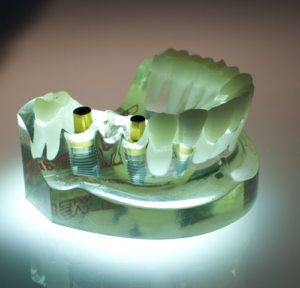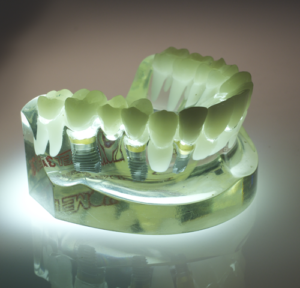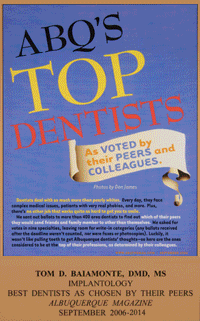
Despite advances in dentistry, people can still suffer from tooth loss. The most common causes are mostly due to tooth decay, gingivitis (gum disease), or injury.
In the past, the only treatment options available for tooth loss were crowns, bridges, and dentures – all of which could be uncomfortable not to mention destructive to your remaining teeth. Today, dental implants eliminate these issues while providing you with the most natural looking smile available.
Dental implants are artificial replacements for missing roots. They provide the foundation for fixed or removable teeth (prosthesis). Because our team does both the surgical and restorative aspects of implant treatment in our office, your new teeth will fit comfortably while functioning and looking like natural teeth.
The surgical procedure is the placement of the artificial root (the portion of the tooth beneath the gumline). Sometimes, patients also require bone reconstruction / regeneration of the jaw before implant(s) can be placed. This procedure can be done in our office as well.
The restorative procedure replaces the crown(s) – the portion of the tooth visible above the gumline.
Implants
First, schedule an initial exam. Our team will review your medical history and perform a clinical oral exam with x-rays to see if a dental implants are right for you.
Based on your exam, we will determine your best treatment options. These options may range from replacing a single tooth to a full-mouth reconstruction. Options may also include bone reconstruction where necessary. To save time and especially to eliminate the possibility of miscommunication between numerous clinitions, all steps of the process can be performed by our office.
Implant and mini-implant placement
Dental implant surgery has a high success rate: 95% in the lower jaw and 90% in the upper. With the absence of one or more teeth, the jaw bone no longer needs to provide support. This results in bone loss which can not be prevented by dentures, partials, or bridges. Implants are the only proven way to reduce bone lass because they transmit chewing forces just like natural teeth.
Implant restoration
Screw-retained crowns and bridges
These crowns and bridges can be retrieved without damage when removed for maintenance or repair. The absence of cement under gingival tissues prevents irritation to the peri-implant soft tissue.
Attachment-retained prostheses (removable)
Missing teeth cause a significant amount of bone loss. Implants with attachments can secure dentures, allowing you to eat and function as if you had your natural teeth.
* Based on your unique needs, before implants and implant restoration can be performed, you may need additional procedures. These include:
Bone graft
An x-ray will allow us to determine if you are a candidate for a bone graft as a result of missing teeth, periodontal gum disease, or wearing a denture for a long period of time.
Sinus lift
Sinuses are hollow chambers above the upper teeth. When these chambers are too large or when there is insufficient bone in the posterior portion of the maxilla to accommodate an implant, a lift or elevation will be necessary to ensure successful implant placement.




